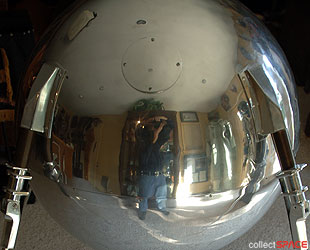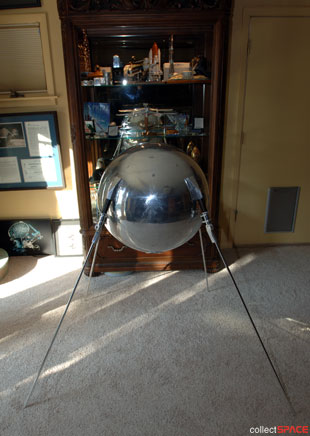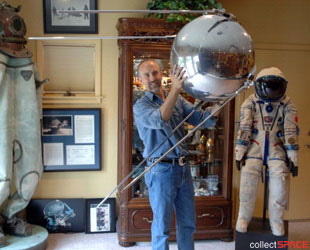October 2, 2007 — Lord British owns a real Sputnik.

Reflecting on history: Garriott photographs his Sputnik. |
The ruler of Britannia, the fictional kingdom in the Ultima series of computer games, is the alter ego of Richard Garriott, the game's successful developer. Garriott, in real life, lives in Brittania Manor, his custom designed 'castle' in Austin, Texas, which, as one might expect, is adorned by the eclectic, from suits of armor to dinosaur fossils to the real Soviet satellite.
That he owns a Sputnik, one of the few produced by the Soviet Union at the same time the original was being built and prepared to make history as the world's first artificial moon, is not at all random. For Lord British also happens to be the son of Skylab and space shuttle U.S. astronaut Owen Garriott.
Growing up the son of a spaceman left an impression on Garriott, instilling an appreciation for space artifacts.
"About 10 years ago I bought a number of Russian space artifacts," Garriott explained to collectSPACE.com. "These included a space suit, a lunar rover (still on the moon), a navigational sphere, some models and one of the original Sputniks. With my father being an astronaut and my own inherited passion for space, all these items seem natural for me to want to collect."
Natural as they might be, Garriott's collectibles are truly one of a kind. His lunar rover (Lunokhod 2) makes him the only individual to own a spacecraft on a celestial body other than Earth. And he may be the only person to own an original Sputnik rather than the replicas found in many museums.
Obtaining such rarities as the Sputnik has inspired some unique situations. For example, there's the small issue of exporting a satellite out of Russia.
"Getting the Sputnik out of Russia and into the [United States] turned out to be an interesting trick, as the large techno-globe required explanation that would allow it to pass through customs without too much trouble, and so in the end the large hemispherical globe halves became known as 'salad bowls,'" shared Garriott.

Garriott's Sputnik standing (with antennae partially retracted) in Britannia Manor before a case of his other space artifacts. |
Once the two 23-inch diameter "bowls" were reunited and mated with the satellite's four long antennae, the question then became where to put it.
"As Sputnik is large, especially with its four rather long 3 meter antennae, it is actually uncommon for me to put on display at my home along with my other space artifacts," said Garriott, which is the reason why the Sputnik is still a secret to many who know him, including his father, the astronaut.
Attention generated by the 50th anniversary of Sputnik's launch however, provided the opportunity for Garriott to tell his father of his "secret" satellite, and for Owen to tell his son of his own connection with the original Sputnik I.
"With the 50th anniversary of Sputnik approaching, John Schwartz of the New York Times began researching what happened to the lost Sputnik duplicates. Through Robert Pearlman of collectSPACE.com, he tracked me and my Sputnik down," Garriott recounted.
"One of the more interesting questions he asked me about Sputnik was what influence Sputnik had on my father's interest in the space program 50 years ago. I told him that honestly, I did not know. Oddly, it had never come up as a home topic of conversation. So, I asked him."
As it turns out, it was a big influence.
"He told me that on Friday, October 4th, 1957 he was a graduate student in the Radio Propagation Laboratory at Stanford University, when news came of the launch of the Russian Sputnik transmitting signals at or about 20 Mhx. That was a frequency they could easily receive at their Radio Propagation field site on the Stanford Campus! Within a few hours most all of the laboratory faculty and grad students had converged on the field site to receive the radio signals and try and understand the 'be-beep, be-beep' as it passed overhead."
"They promptly noticed the 'Doppler shift,'" said Garriott, "like the acoustic sound of a train passing by, which they soon understood was produced by 'polarization rotation' of the received radio waves. The signals could be heard for 5-10 minutes every hour and a half for 3 or 4 orbits each day."
"This proved a fantastic opportunity for my dad to get started in research on radio signals from earth satellites and the effects produced on them by passage through the earth's ionosphere at the very beginning of the space age," he continued. "This became the topic of his PhD dissertation completed about 2 years later. I would add that this would clearly be of direct interest to NASA, and likely a factor in his being selected in the first round of scientist astronauts."
And just as Sputnik 1 led to Owen Garriott flying to the United States' first space station, the research he conducted as a result of the world's first satellite started his son, Richard, on the path to follow him into space.
"Interestingly, in the 1970s, at the dawn of the personal computer age, my junior and senior year science fair project was to do a computer graph of radio wave propagation in the ionosphere. And while clearly I had help with the mathematics from my dad, my work was likely some of the first such simulations done, as it was early in the years of possibility, since computers were still so new," observed Richard Garriott.
Garriott's early work in computers eventually led him to developing the longest running computer game series, Ultima, which in turn led him to earn the millions of dollars necessary to buy not just an original Sputnik, but a seat on an upcoming Russian Soyuz rocket to launch him to the International Space Station. When he reaches space next fall, he will be the first second generation American astronaut.
"It was great for me to learn of my father's connection to Sputnik and he too got pleasure from knowing I had acquired one of the original duplicates," reflected Garriott, "even if we both heard about it many years late!"

Richard Garriott poses with his Sputnik satellite. |
Learn more:

